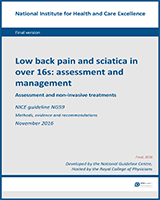Excerpt
This guideline covers the assessment and management of low back pain and sciatica in adults over the age of 16 years.
Low back pain causes more disability, worldwide, than any other condition. Episodes of back pain are usually transient with rapid improvements in pain and disability seen within a few weeks to a few months. Whilst the majority of back pain episodes resolve improve with initial primary care management, without the need for investigations or referral to specialist services, up to one third of patients report persistent back pain of at least moderate intensity one year after an acute episode requiring care and episodes of back pain often recur.
One of the greatest challenges remains the identification of risk factors that may predict the progression from a single back pain episode to a long term, persistent pain condition where quality of life is often very low and healthcare resource use high.
A complex and variable interplay between biological, psychological and social factors undoubtedly influences this progression and it is the modification of these factors that has become one of the mainstays of back pain research and treatment over the last decade or so.
The scope of this guideline is necessarily broad. We have reviewed the evidence for treatments and interventions individually and when used in combination - from self-management advice and simple non-invasive interventions to injections, nerve ablation techniques and spinal fusion.
We have reviewed the evidence for treatment stratification and the effectiveness of tailoring treatments to these stratified groups in the hope that clinicians know which patients are likely to need more focused and intensive treatment and which patients are likely to improve rapidly with primary care management alone, without the need for investigations or referral to specialised services.
Contents
- Guideline Development Group members
- NGC technical team members
- Co-optees
- Acknowledgements
- 1. Guideline summary
- 2. Introduction
- 3. Development of the guideline
- 4. Methods
- Assessment and Non-Invasive Treatments
- Invasive Treatments
- Appendices A – G
- Appendix H. Clinical evidence tables
- Appendices I-J
- Appendices K-Q

